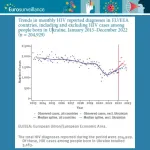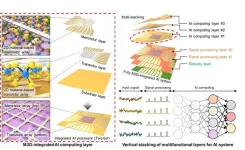EU/EEA: HIV diagnoses rise for the first time in a decade
The increase in 2022 can be attributed to several factors including restoring surveillance activities, scale-up and introduction of novel testing strategies in many countries, migration patterns, lifting of COVID-19 restrictions and arrival of refugees
2023-11-30
(Press-News.org) Across the 30 countries of the European Union and European Economic Area (EU/EEA), 22,995 new HIV diagnoses were reported in 2022. Almost every second new HIV diagnosis (49%, n=11,103) was among migrants, i.e. among people who were not born in in the country they were diagnosed in. born abroad from the country of their diagnosis.
In the aftermath of Russia’s invasion of Ukraine in 2022, more than 4 million Ukrainians took refuge in countries of the European Union and European Economic Area (EU/EEA). In a rapid communication published in Eurosurveillance prior to World AIDS Day 2023 on 1 December, Reyes-Urueña et al. look at most recent surveillance data to assess potential impact on HIV case reporting in the region since the start of the war in Ukraine. [1]
Based on 2022 data, EU/EEA countries have observed an increase in new HIV diagnoses which is attributed to several factors including restoring surveillance activities, scale-up and introduction of novel testing strategies in many countries, migration patterns, lifting of COVID-19 restrictions and the arrival of refugees. However, 10% of all new HIV diagnoses in the EU/EEA last year were made among Ukrainian refugees (n=2,338). This constitutes a 10-fold increase compared with 2021 (n=223).
Among the 2,338 Ukrainian refugees diagnosed with HIV in the EU/EEA in 2022, 9% (n=217) were diagnosed for the first time in the reporting country while the majority (59%, n=1,368) had been notified about their HIV status before 2022. For around a third (32%), this information was unknown. Half of those that had previously been diagnosed with HIV were on antiretroviral treatment at the time of reporting in 2022.
Host countries need tailored early testing and treatment approaches
Overall, the EU/EEA notification rate of HIV cases in 2022 was 5.1 per 100,000 population which constitutes a 31% increase compared with 2021 (3.9/100,000 population), but a decrease of 3.8% compared with 2019 (5.3/100,000 population).
In the group of Ukrainian people diagnosed with HIV, women are the most affected accounting for the bigger part of new diagnoses (n=1,585) with heterosexual sex as primary transmission mode.
The authors also highlight that “among cases with known data on previous diagnosis, the prevalence of late HIV diagnosis (47.0%) and AIDS (18.9%) among newly diagnosed people underscores the urgent need for tailored early testing and linking to care in host countries.”
According to Reyes-Urueña et al., the results of their study have important implications for HIV prevention, testing, treatment, stigma-reduction and surveillance in EU/EEA countries: “Prevention that is accessible to new migrant populations, including pre-exposure prophylaxis for HIV (PrEP) as well as needle and syringe programmes and drug treatment for people who use drugs are crucial, especially given that refugees have well-documented vulnerabilities that may incur higher HIV acquisition risk.”
----Ends----
References/notes to editors:
[1] Reyes-Urueña Juliana, Marrone Gaetano, Noori Teymur, Kuchukhidze Giorgi, Martsynovska Violetta, Hetman Larysa, Basenko Anton, Bivol Stela, van der Werf Marieke J, Pharris Anastasia, on behalf of the EU/EEA HIV network, Euro Surveill. 2023;28(48):pii=2300642. Available from: https://doi.org/10.2807/1560-7917.ES.2023.28.48.2300642
[2] See also the paper in the same Eurosurveillance issue from Wärnberg et al. on “The molecular epidemiology of HIV-1 in Sweden 1996 to 2022, and the influence of migration from Ukraine”. The authors look at the distribution of HIV-1 subtypes in Sweden since the beginning of the AIDS epidemic. Available from: https://doi.org/10.2807/1560-7917.ES.2023.28.48.2300224
[3] World AIDS Day was introduced by the World Health Organization (WHO) in 1988 and is observed annually on 1 December to raise awareness of the AIDS pandemic caused by HIV infection. See also: World AIDS Day 2023 (europa.eu)
[4] HIV/AIDS: The human immunodeficiency virus (HIV) is a virus, which attacks the immune system and causes a lifelong severe illness with a long incubation period. The end-stage of the untreated infection, acquired immunodeficiency syndrome (AIDS), results from the destruction of the immune system. AIDS is defined by the presence of one or more “opportunistic” illnesses (other illnesses due to decreased immunity).
[5] Late diagnosis is defined as having a CD4 cell count below 350 cells/mm3 blood at the time of diagnosis. This is a measure of the person’s immune system functioning.
[6] Sustainable Development Goals (SDG) and 90–90–90 targets: in 2015, 17 Sustainable Development Goals (SDGs), each with specific targets for 2030, were introduced by the UN, including target 3.3 to end AIDS as a public health threat by 2030. In 2014, UNAIDS and partners launched the so-called ‘90–90–90 targets’ with the aim for 2020 that 90% people living with HIV are diagnosed (early) and 90% of those diagnosed receive antiretroviral treatment (ART), which leads to viral suppression among 90% of those on such treatment, i.e. the virus is no longer detectable in the blood. Such an undetectable viral load also means that HIV-positive people on effective treatment do not transmit the virus. In 2021, the Joint United Nations Programme on HIV/AIDS (UNAIDS) updated the HIV targets for 2025 as part of the global strategy to end HIV transmission by 2030. The latest data on progress towards these 95-95-95 targets across Europe and Central Asia can be found here: Continuum of HIV care - Monitoring implementation of the Dublin Declaration on partnership to fight HIV/AIDS in Europe and Central Asia: 2022 progress report (europa.eu)
END
[Attachments] See images for this press release:


ELSE PRESS RELEASES FROM THIS DATE:
2023-11-30
Multifunctional computer chips have evolved to do more with integrated sensors, processors, memory and other specialized components. However, as chips have expanded, the time required to move information between functional components has also grown.
“Think of it like building a house,” said Sang-Hoon Bae, an assistant professor of mechanical engineering and materials science at the McKelvey School of Engineering at Washington University in St. Louis. “You build out laterally and up vertically to get more ...
2023-11-30
Boston – George Demetri, MD, director of the Sarcoma Center at Dana-Farber Cancer Institute, is being awarded the prestigious J.E. Wallace Sterling Lifetime Achievement Award in Medicine from the Stanford Medicine Alumni Association (SMAA). Demetri, an alumnus of the Stanford University School of Medicine, Class of 1983, will be honored at a dinner held on the Stanford University School of Medicine campus on December 4, 2023.
“Dr. Demetri is a leader in developing targeted therapeutics for cancer and has been pivotal in advancing oncology treatments ...
2023-11-30
By studying the skull shapes of dipsadine snakes, researchers at The University of Texas at Arlington have found how these species of snakes in Central and South America have evolved and adapted to meet the demands of their habitats and food sources.
The research, conducted in collaboration with colleagues at the University of Michigan, was published in the peer-reviewed journal BMC Ecology and Evolution.
“We now have evidence that this group of snakes is one of the most spectacular and largest vertebrate adaptive radiations currently known to science,” said Gregory Pandelis, collections manager at UTA’s Amphibian and Reptile Diversity ...
2023-11-30
INDIANAPOLIS—Indiana University researchers are collaborating on a novel approach to use neuroimaging and network modeling tools—previously developed to analyze brains of patients in the clinic—to investigate Alzheimer’s disease progression in preclinical animal models.
The research team, led by Evgeny Chumin, PhD, a postdoctoral research fellow in the College of Arts and Sciences' Department of Psychological and Brain Sciences at IU Bloomington, and Paul Territo, PhD, professor of medicine at the IU School of Medicine, published their findings in Alzheimer’s & Dementia: The Journal of ...
2023-11-30
ITHACA, N.Y. -- In sea fireflies’ underwater ballet, the males sway together in perfect, illuminated synchronization, basking in the glow of their secreted iridescent mucus.
“It’s extreme,” said Nicholai M. Hensley, a postdoctoral fellow in the Department of Neurobiology and Behavior in the College of Arts and Sciences. “It’s an illustration of convergent evolution and a striking example of synchronized bioluminescent mating displays. The males are putting it all out on the dance floor. It’s a big bright display.”
Hensley is the lead author of new research unwrapping the vivid mating ...
2023-11-30
Philadelphia, November 30, 2023 – Everyone should get quality care, no matter the color of their skin. However, implicit bias, micro-aggressions, and a lack of cultural understanding persist, leading to oppression and unequal treatment in healthcare. An insightful article in the new themed issue of the Journal of Medical Imaging and Radiation Sciences on specialized populations, published by Elsevier, highlights this serious problem, specifically addressing the assessment and treatment of radiation-induced skin reactions (RISR) in patients across the world undergoing external beam radiotherapy.
The article provides a stark example ...
2023-11-30
(Boston)—Pranay Sinha, MD, assistant professor of medicine at Boston University Chobanian & Avedisian School of Medicine, has received a National Institutes of Health Mentored Research Scientist Development Award (K01). These awards provide support and protected time (three to five years) for an intensive, supervised, career development experience in the biomedical, behavioral or clinical sciences, leading to research independence.
As part of this honor, Sinha has received a five-year, $640,508 National Institute of Allergy and Infectious Diseases grant for his project, “Nutritional Interventions to End Tuberculosis ...
2023-11-30
Long before researchers discovered the electron and its role in generating electrical current, they knew about electricity and were exploring its potential. One thing they learned early on was that metals were great conductors of both electricity and heat.
And in 1853, two scientists showed that those two admirable properties of metals were somehow related: At any given temperature, the ratio of electronic conductivity to thermal conductivity was roughly the same in any metal they tested. This so-called Wiedemann-Franz law has held ever since – except in quantum materials, where electrons stop behaving as individual particles and glom together into a sort of electron soup. ...
2023-11-30
Dogs’ food preferences are mirrored in their brain activity, particularly within their caudate nuclei -a brain region associated with reward processing, a new study combining behavioural and neuroimaging data by researchers from the Department of Ethology, Eötvös Loránd University (Hungary) and Symrise Pet Food (France) finds. The study, which seamlessly blends behavioral observations with advanced neuroimaging techniques, offers novel insights into the influence of food quality on dogs' motivation. This work has been published in Scientific Reports.
Similar to people, ...
2023-11-30
Four in five primary caregivers of nine-month-old babies reported cuddling, talking and playing with their little one several times a day, in England's first national long-term study of babies in over two decades, led by UCL (University College London).
More than half engaged in physical or turn-taking play, singing, pretend games and noisy play with their babies several times a day – activities which were linked to improved early language development. Around three quarters showed their babies picture ...
LAST 30 PRESS RELEASES:
[Press-News.org] EU/EEA: HIV diagnoses rise for the first time in a decade
The increase in 2022 can be attributed to several factors including restoring surveillance activities, scale-up and introduction of novel testing strategies in many countries, migration patterns, lifting of COVID-19 restrictions and arrival of refugees







